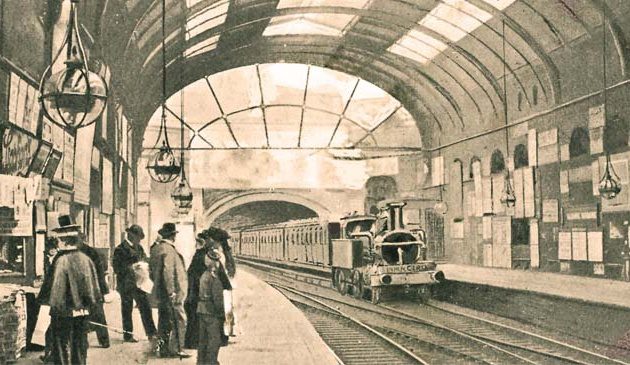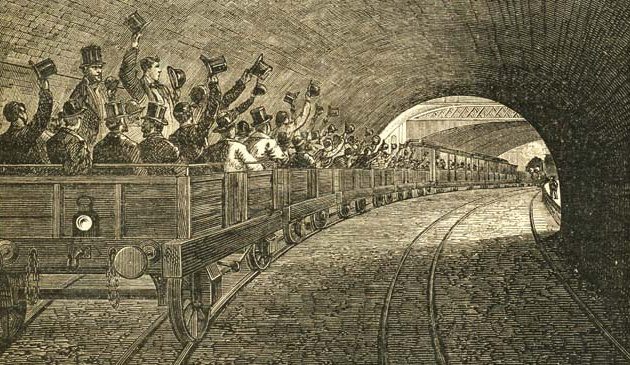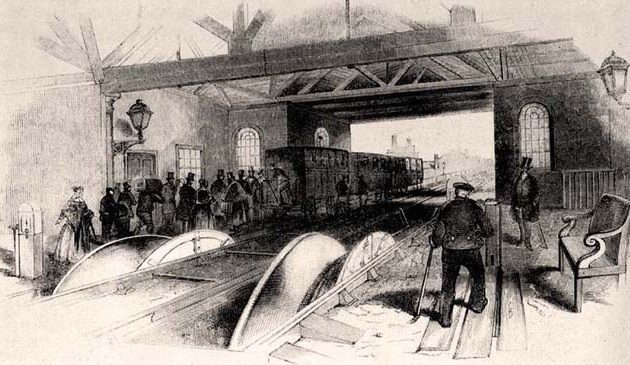London’s first railway

The London & Greenwich Railway ran along a four-mile long viaduct from Tooley Street on the south side of London Bridge. Much of its route was still rural as can be seen here where the line passed over Spa Road at Bermondsey.
The company’s London Bridge station was the earliest of the capital’s great railway termini. It was initially a simple affair, consisting of little more than three tracks and two platforms at the end of the viaduct. The company had to buy out many owners of small properties to make space for the station. The ancient St. Olave’s Free Grammar School was demolished, and St. Thomas’s Hospital, which adjoined the site, proved a continuous obstacle to future expansion.
A sixty-yard ramp, named Dottin Street after the L&GR director Abel Dottin, led down from the terminus to street level. Initially there was no protection from the elements but after a few weeks a makeshift tarred canvas was hung at the top of the street. A three-storey building at the top of the ramp housed the booking office and company offices. There had been plans for a grand entrance but by the time the line had been constructed there were no funds available.
In December 1836 the line from London Bridge was open as far as a temporary station at Deptford and was ready to be officially opened. A ceremony was performed by the Lord Mayor at London Bridge station with music from the Scots Fusiliers. The Coldstream Guards gave a performance at the other end of the line. In that same year a Bill was drafted to extend the line to Dartford further along the Thames Estuary, but that section never materialized. It took another two years before it even reached Greenwich.
Trains ran every fifteen minutes and typically carried around 32,000 passengers each week. Season tickets, known then as ‘free tickets’, were issued, the first on record. Tickets were in the form of a small copper disc, which were repeatedly recycled.
The cost of first- and second-class tickets was high but there was initially enough curiosity that the line was well patronised. To increase passenger numbers a cheaper third-class fare was added in 1839, with those passengers standing in an additional two carriages. The company found it difficult to keep the public off the tracks and the first fatal accident occurred in March 1836, just a month after services began. A permanent Greenwich station, an elaborate building, opened in April 1840.
By the time the London & Greenwich Railway opened other companies were planning new lines south of the Thames, yet only one railway had been authorised by Parliament into London from the south. The L&G therefore made agreements for other railways servicing a variety of destinations to enter the capital over its viaduct. A separate station was built at London Bridge for those other railways and within a few years it was possible to travel from there to many parts of Kent and Sussex, as far as Dover and Brighton.
The London & Greenwich was ground-breaking as a means of bringing people in and out of the capital from nearby towns and suburbs. Most other railways built in subsequent years, such as the London & Birmingham from its terminus at Euston, or the Great Western from Paddington, failed to follow the L&GR’s lead in servicing London’s local needs and instead concentrated on long-distance travel.
The line struggled to make adequate profits in its early years until trains of other companies were running over its tracks and paying for that privilege. Following the London & Greenwich, a complex and comprehensive system of local railways quickly evolved to the south of London, where land prices were much cheaper than in the northern suburbs. Therefore, when the Underground network began to evolve during later decades there was less need for it south of the Thames.
Sources include: G.A. Sekon ‘Locomotion in Victorian London’; Christian Wolmar ‘Cathedrals of Steam’; Christian Wolmar ‘The Subterranean Railway’; Edward Walford ‘Old and New London’; John Richardson ‘The Annals of London’; Jerry White ‘London in the 19th Century’; Ian Petticrew, Wendy Austin, ‘The Train Now Departing’ https://tringlocalhistory.org.uk/Railway/index.htm; David Crawford, London Topographical Society, May 2021.
< Back to London in the mid-19th century


